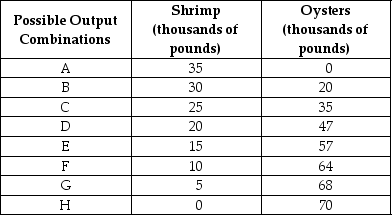Table 2-7

-Refer to Table 2-7. The Shellfish Shack produces only shrimp and oysters. The table above shows the maximum possible output combinations of the two types of shellfish using all resources and currently available technology.
a. Suppose The Shellfish Shack is currently producing at point E. What is the opportunity cost of producing an additional 11,000 pounds of oysters?
b. Suppose The Shellfish Shack is currently producing at point E. What happens to the opportunity cost of producing more and more shrimp? Does it increase, decrease, or remain constant? Explain your answer.
c. Suppose The Shellfish Shack is currently producing at point B. What happens to the opportunity cost of producing more and more oysters? Does it increase, decrease, or remain constant? Explain your answer.
d. Suppose The Shellfish Shack is plagued by a disease which destroys oyster beds but not shrimp habitats. What would happen to its PPF?
Definitions:
One-Way Model
A communication model where information flows in only one direction, from sender to receiver, without feedback.
Circular Model
A communication model that emphasizes feedback, indicating that communication is a continuous and dynamic process.
Transaction Model
A communication framework that considers the dynamic and reciprocal exchange of messages between sender and receiver, including the context and potential for feedback.
Formal Communication
Structured exchange of information that follows established protocols or rules within an organization.
Q80: Why is it necessary for all economic
Q141: What is the difference between product markets
Q144: Assume that microbrewery beer is a normal
Q155: Pierre can produce either a combination of
Q201: Refer to Figure 2-12. If the two
Q263: Refer to Table 1-1. What is Lydia's
Q337: Refer to Table 2-4. Dina faces _
Q380: Refer to Figure 2-15. In the circular
Q449: Refer to Figure 2-4. A movement from
Q450: The _ the sale of an additional